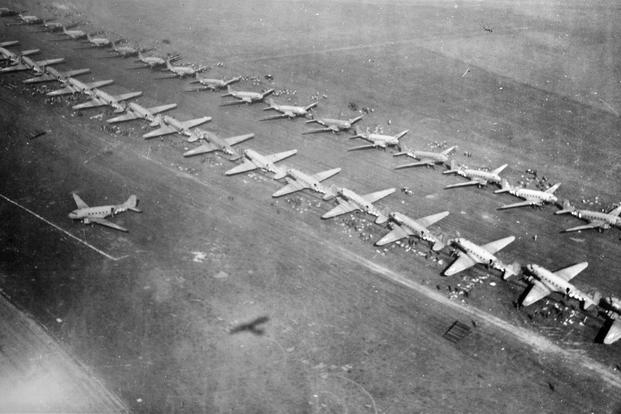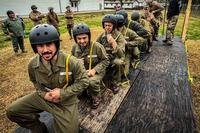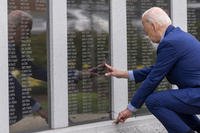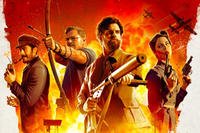My name is Roger Airgood and [I] live in Lafayette, Indiana. Today's date is October 24, 1992. I was born in Indiana on March 1, 1921. I entered the Army Air Corps at Chanute Field, IL, on May 22, 1939. I remained in the service until going into inactive reserves on October 19, 1945.
I was a twin-engine pilot flying C-47s as a second lieutenant. At Chanute Field, I was a radio operating instructor and a teletype maintenance instructor until I entered pilot training in June 1942. I received my wings and commission on March 20, 1943. Then I was assigned to Troop Carrier training in Alliance, Nebraska, and Maxton, North Carolina.
We arrived in Bottesford, England, in January 1944, then moved to Membury Field in Berkshire. We had several practice missions with airborne, both paratroopers and glider infantry. About June 4th, we were restricted to base and briefed on the pending missions. There was no outgoing mail. On the afternoon of the 4th after the briefing, all flight personnel were segregated from the non-flying personnel.
Also on the 4th, black and white paint was used to paint the invasion strips on the aircraft. The purpose of the invasion stripes was to aid naval forces in identifying allied aircraft. On the evening of the 4th, the mission was postponed. For several days, the airborne troops had been moved onto our base and slept on cots in the hangars. They were sweating out the mission also under severe restrictions.
On June 5th, we proceeded on schedule on double daylight time. All crews and airborne reported to their aircraft at 2200 hours. This provided about 40 minutes to help load the paratroopers and check out the aircraft. We had to help load the heavily burdened paratroopers. All had leg packs tethered to their waists. These packs would be lowered after the jump so the sacks weighing 40 to 80 pounds would hit the ground first.
We had worked with the airborne before and they were cocky, unruly characters, but this time, they were very serious. A couple of them had us lace the strap from their backpacks so they would have to cut the strap to get out of the chute.
We started the engines at 2240 and taxied into take-off position so we could get the planes up and in a V of Vs formation very quickly. Take-off was at 2300. We had a very precise route to follow over the channel and across Normandy. The return route brought us back over the outbound route. Although we experienced many night formations with paratroopers in the States and in England, the plan for getting the troops to the drop zones in Normandy was the most complex and ambitious mission we had ever faced.
There were several changes in altitude and direction over the course. There were no checkpoints from the IP to the DZ to aid in maintaining the desired course. The pathfinders who were supposed to be on the DZ did not reach the area, and no signals were emitted.
Our serial of six weaves of nine planes each was led by Lt. Col. (John) Kreyssler of the 79th Troop Carrier Squadron followed by the 80th TCS and 85th TCS. Len Hayes and I were in the left flight lead position of the first wave. Len was in the pilot's seat, and I was in the copilot's seat (right side).
Everything was working fine as scheduled until we got to the last light boat, at which time we were to turn off the amber down light and reduce the formation lights to half power. The formation lights (shielded blue lights on top of the fuselage and wings) were controlled by a rheostat; there was no half-power position.
The pilot flying on Kreyssler's left wing turned off the formation lights so low, they were not visible. At that time, Hayes could see nothing of Kreyssler's wing man from the left seat, so I flew from the right seat since I could see the exhaust stack glow and the phantom outline of the plane. We maintained our position flying as tight a formation as possible.
When entering an unexpected cloud bank, we continued on without any appreciable difference in visibility. We maintained the course, and when coming out of the cloud bank, we could see tracers coming up from many angles. The lines of tracers arched over us as we flew under them. There was a tremendous racket such as experienced when flying through hail.
I had very few glimpses of the ground since I had to keep the outline of the plane in sight. It was standard procedure for the serial leader to show red or green lights from the astrodome so that all pilots would signal the jumpmasters. It was done this way so that all the troopers would jump in unison. Shortly after getting the four-minute red warning light (stand up and hook up), I got a glimpse of a steeple of a church about a half mile ahead and off to the right about a quarter of a mile.
Assuming this to be St. Mere Eglise, I felt we were on course and that DZ "A" lay straight ahead. There seemed to be a delay in slowing down to the jump speed of 110 mph. When Kreyssler did slow down, it was too fast. Wingmen had to cut power and hold the nose up to keep from over-running the lead planes, which in turn was followed by a blast of power to keep the plane from stalling out.
The net result was that when we got the green light, we were flying about 105 mph and pulling a lot of power. The paratroopers went out in a terrific prop blast, which was the last thing we wanted to happen. We dropped our troopers at 0102 on June 6th. As soon as the paratroopers were out, Kreyssler dove to get down to 100 feet. Before I could follow in the dive, the lead flight was out of sight.
We had another ticklish problem, also. As the troopers jumped, we had a strong stench of gasoline in the cockpit and cabin. When I lost sight of the lead flight, Len Hayes took control, descended and turned to the new heading. I checked the gas tanks and found the main tank we were using for the right engine indicated empty. I switched to the auxiliary tank even though the engine was still running.
Being busy, I did not see the beach after we left the DZs. Norbert MIlczewski, navigator, told Hayes when three minutes were up to turn again. We checked frequently to see if our wingmen were still in position. Wank and Butz were on our right wing and Camp and Shurman on the left. They stayed with us all the way to Membury.
The trip home was uneventful even though no one dared smoke in this potentially dangerous situation. Coming back across the Channel at 3,000 ft., planes and gliders at 500 ft. lit up a continuous column going into Normandy. I didn't envy those glider pilots having to fly and land in the dark. When we landed at Membury, Hayes turned off into the first available hardstand and very cautiously shut down the engines.
When Hayes and I alighted, Norb Milczewski, Hoytt Rose and Tom Anderson were already standing about 100 feet away in the grass. Gasoline was running out of the tail and the moisture drain holes along the trailing edge of the wing. Later, it was found that a 30-caliber slug had punctured the tank and lodged in the float. The hole in the tank was the only hit we had.
I have always assumed the steeple I saw was at St. Mere Eglise. Lately I learned there are at least seven steeples in the eastern part of Normandy. I cannot be sure which one I saw. I have never heard of any of our crews that saw a steeple. For our missions over enemy lines, we used every conceivable means to assure safety for the crew.
Typically, we wore flight suites or fatigues. Everyone wore a floatation device called a Mae West. The pilots wore a chest pack harness over their Mae Wests. It was too cramped in the cockpit to wear seat pack parachutes. We used chest pack parachutes that were stored behind the cockpit. If necessary, the chest packs were clipped onto the harness while en route to the door to exit the aircraft. Other crew members wore regular seat pack parachutes.
We were issued British flak suits, which consisted of two pieces, front and back, that were fastened at the shoulders and sides. Most used a third piece to sit on. Pilots wore goggles and a steel helmet in case the windshield was damaged or blown out. Basically the C-47 was unarmed, lacked armor and self-sealing fuel tanks -- sometimes referred to as a "sitting duck."
Want to Know More About the Military?
Be sure to get the latest news about the U.S. military, as well as critical info about how to join and all the benefits of service. Subscribe to Military.com and receive customized updates delivered straight to your inbox.















